Submitted:
23 January 2024
Posted:
24 January 2024
You are already at the latest version
Abstract
Keywords:
1. Introduction
2. Materials and Methods
2.1. Study Area:
2.2. Data Used
2.3. Methodology
3. Results and Discussion
4. Conclusions and Recommendation
Author Contributions
Data Availability Statement
Conflicts of Interest
References
- Farzana, S.Z.; Zafor, M.A.; Al Shahariar, J. Application of SWAT Model for Assessing Water Availability in Surma River Basin. Journal of the Civil Engineering Forum 2019, 5, 29–38. [Google Scholar] [CrossRef]
- Pu J. H., Pandey M., Li J., Satyanaga A, Kundu S., Hanmaiahgari P. R., and Shao S., (eds.) “The Urban Fluvial and Hydro-Environment System,”, 2023, Frontiers Media SA. Lausanne.
- Pu J. H., (ed.) “Environmental Hydraulics, Turbulence and Sediment Transport,” MDPI Publisher, 2022, ISBN 978-3-0365-3242-4 (Hbk); ISBN 978-3-0365-3243-1 (PDF).
- Marhaento, H.; Booij, M.J.; Rientjes, T.H.; Hoekstra, A.Y. Attribution of changes in the water balance of a tropical catchment to land use change using the SWAT model. Hydrological processes 2017, 31, 2029–2040. [Google Scholar] [CrossRef]
- Bal, M.; Dandpat, A.K.; Naik, B. Hydrological modeling with respect to impact of land-use and land-cover change on the runoff dynamics in Budhabalanga river basing using ArcGIS and SWAT model. Remote Sensing Applications: Society and Environment 2021, 23, 100527. [Google Scholar] [CrossRef]
- Pu, J.H.; Shao, S.; Huang, Y.; Hussain, K. Evaluations of SWEs and SPH Numerical Modelling Tech-niques for Dam Break Flows. Engineering Applications of Computational Fluid Mechanics 2013, 7, 544–563. [Google Scholar] [CrossRef]
- Pu, J.H.; Huang, Y.; Shao, S.; Hussain, K. Three-Gorges Dam Fine Sediment Pollutant Transport: Turbulence SPH Model Simulation of Multi-Fluid Flows. Journal of Applied Fluid Mechanics 2016, 9, 1–10. [Google Scholar] [CrossRef]
- Mestry, A.; Narwade, R.; Nagarajan, K. Estimation of water balance components of watersheds in the Manjira River Basin using SWAT model and GIS. Int J Eng Adv Technol. 2020, 9, 3898–3907. [Google Scholar] [CrossRef]
- Hanmaiahgari, P.R.; Gompa, N.R.; Pal, D.; Pu, J.H. Numerical Modeling of the Sakuma Dam Reservoir Sedimentation. Natural Hazards 2018, 91, 1075–1096. [Google Scholar] [CrossRef]
- Ghosh, A.; Roy, M.B.; Roy, P.K.; Mukherjee, S. Assessing the nature of sediment transport with bridge scour by 1D sediment transport model in the sub-catchment basin of Bhagirathi–Hooghly river. Modeling Earth Systems and Environment 2021, 7, 2823–2845. [Google Scholar] [CrossRef]
- Pu, J.H. Turbulent rectangular compound open channel flow study using multi-zonal approach. Environmental Fluid Mechanics 2019, 19, 785–800. [Google Scholar] [CrossRef]
- Pu, J.H.; Pandey, M.; Hanmaiahgari, P.R. Analytical modelling of sidewall turbulence effect on streamwise velocity profile using 2D approach: A comparison of rectangular and trapezoidal open channel flows. Journal of Hydro-environment Research 2020, 32, 17–25. [Google Scholar] [CrossRef]
- Pu, J.H. Conceptual Hydrodynamic-Thermal Mapping Modelling for Coral Reefs at South Singapore Sea. Applied Ocean Research 2016, 55, 59–65. [Google Scholar] [CrossRef]
- Beasley, D.B.; Huggins, L.F.; Monke, E.J. ANSWERS: a model for watershed planning. Transactions, American Society of Agricultural Engineers 1980, 23, 938–944. [Google Scholar] [CrossRef]
- Leavesley, G.H.; Markstrom, S.L.; Restrepo, P.J.; Viger, R.J. A modular approach to addressing model design, scale, and parameter estimation issues in distributed hydrological modelling. Hydrol Process 2002, 16, 173–187. [Google Scholar] [CrossRef]
- Young, R.A.; Onstad, C.A.; Bosch, D.D.; Anderson, W.P. AGNPS: A nonpoint-source pollution model for evaluating agricultural watersheds. J Soil Water Conservation 1989, 44, 168–173. [Google Scholar]
- Laflen, J.M.; Lane, L.J.; Foster, G.R. A new generation of erosion prediction technology. 1991. [Online]. Available: www.swcs.org.
- Julien, P.Y.; Saghafian, B.; Ogden, F.L. Water Resources Bulletin Raster-Based Hydrologic Modeling Of Spatially-Varied Surface Runoff. Journal of the American Water Resources Association 1995. [CrossRef]
- Donigian, A.S., Jr.; Bicknell, B.R.; Imhoff, J.C. Hydrological Simulation Program-Fortran (HSPF). Computer models of watershed hydrology 1995, 395–442. [Google Scholar]
- Srinivasan, R.; Arnold, J.G.; Jones, C.A. Hydrologic modelling of the United States with the soil and water assessment tool. Int J Water Resour Dev 1998, 14, 315–325. [Google Scholar] [CrossRef]
- Sivapalan, M.; Viney, N.R.; Zammit, C. LASCAM: large scale catchment model. Mathematical models of large watershed hydrology 2002, 579–648. [Google Scholar]
- Borah, D.K.; Bera, M.; Shaw, S.; Keefer, L. Dynamic Modeling and Monitoring of Water, Sediment, Nutrients, and Pesticides in Agricultural Watersheds during Storm Events. 1999.
- Young, R.A.; Onstad, C.A.; Bosch, D.D.; Anderson, W.P. AGNPS: A nonpoint-source pollution model for evaluating agricultural watersheds. J Soil Water Conserv 1989, 44, 168–173. [Google Scholar]
- Younis, S.M.Z.; Majid, M.; Ammar, A. Satellite-based rainfall estimation and discharge measurement of Middle Indus River, Pakistan. Arabian Journal of Geosciences 2017, 10. [Google Scholar] [CrossRef]
- Koneti, S.; Sunkara, S.L.; Roy, P.S. Hydrological modeling with respect to impact of land-use and land-cover change on the runoff dynamics in Godavari River basin using the HEC-HMS model. ISPRS Int J Geoinf 2018, 7. [Google Scholar] [CrossRef]
- Geng, X.; Wang, X.; Yan, H.; Zhang, Q.; Jin, G. Land use/land cover change induced impacts on water supply service in the upper reach of Heihe River Basin. Sustainability (Switzerland) 2015, 7, 366–383. [Google Scholar] [CrossRef]
- Garg, V.; Nikam, B.R.; Thakur, P.K.; Aggarwal, S.P.; Gupta, P.K.; Srivastav, S.K. Human-induced land use land cover change and its impact on hydrology. HydroResearch 2019, 1, 48–56. [Google Scholar] [CrossRef]
- Biru, Z.; Kumar, D. Calibration and validation of SWAT model using stream flow and sediment load for Mojo watershed, Ethiopia. Sustain Water Resour Manag 2018, 4, 937–949. [Google Scholar] [CrossRef]
- Li, Y.; et al. Spatiotemporal impacts of land use land cover changes on hydrology from the mechanism perspective using SWAT model with time-varying parameters. Hydrology Research 2019, 50, 244–261. [Google Scholar] [CrossRef]
- Munoth, P.; Goyal, R. Impacts of land use land cover change on runoff and sediment yield of Upper Tapi River Sub-Basin, India. International Journal of River Basin Management 2020, 18, 177–189. [Google Scholar] [CrossRef]
- Júnior, R.F.; Montenegro, A. Impact of land use change on the water balance in a representative watershed in the semiarid of the state of Pernambuco using the swat model the main springs and streams are generally intermittent, and both native vegetation and the watershed. The Aim. 2019, 4430, 110–117. [Google Scholar]
- Manaswi, C.M.; Thawait, A.K. Application of soil and water assessment tool for runoff modeling of Karam River basin in Madhya Pradesh. International Journal of Scientific Engineering and Technology 2014, 3, 529–532. [Google Scholar]
- Pandi, D.; Kothandaraman, S.; Kuppusamy, M. Simulation of water balance components using SWAT model at sub catchment level. Sustainability 2023, 15, 1438. [Google Scholar] [CrossRef]
- Eckhardt, K.; Arnold, J. Automatic calibration of a distributed catchment model. J. Hydrol. 2001, 251, 103–109. [Google Scholar] [CrossRef]
- White, K.; Chaubey, I. Sensitivity analysis, calibration, and validations for a multisite and multivariable SWAT model. J. Am. Water Resour. Assoc. 2005, 41, 1077–1089. [Google Scholar] [CrossRef]
- Lu, Z.; Zou, S.; Xiao, H.; Zheng, C.; Yin, Z.; Wang, W. Comprehensive hydrologic calibration of SWAT and water balance analysis in mountainous watersheds in northwest China. Physics and Chemistry of the Earth, Parts A/B/C 2015, 79, 76–85. [Google Scholar] [CrossRef]
- Roy, M.B.; Ghosh, A.; Kumar, A.; Roy, P.K. Study of water productivity model on wetlands: a case study of Bhagirathi-Hooghly sub-catchment basin, Southern West Bengal, India. Environ Monit Assess 2021, 193, 1–23. [Google Scholar] [CrossRef] [PubMed]
- Ghosh, A.; Roy, M.B.; Roy, P.K. Estimation and prediction of the oscillation pattern of meandering geometry in a sub-catchment basin of Bhagirathi-Hooghly River, West Bengal, India. SN Appl Sci 2020, 2. [Google Scholar] [CrossRef]
- Ghosh, A.; Roy, M.B.; Roy, P.K. Evaluating the performance of MIKE NAM model on rainfall–runoff in lower Gangetic floodplain, West Bengal, India. Model Earth Syst Environ 2022, 8, 4001–4017. [Google Scholar] [CrossRef]
- Chiphang, N.; Bandyopadhyay, A.; Bhadra, A. Assessing the effects of snowmelt dynamics on streamflow and water balance components in an Eastern Himalayan river basin using SWAT model. Environmental Modeling & Assessment 2020, 25, 861–883. [Google Scholar]
- Ahn, S.R.; Kim, S.J. Analysis of water balance by surface–groundwater interaction using the SWAT model for the Han River basin, South Korea. Paddy and Water Environment 2018, 16, 543–560. [Google Scholar] [CrossRef]
- Abbaspour KC (2015) SWAT-CUP: SWAT Calibration and Uncertainty Programs – A User Manual, Department of Systems Analysis, Integrated Assessment and Modelling (SIAM), Eawag. Swiss Federal Institute of Aquatic Science and Technology, Duebendorf.
- Nasiri, S.; Ansari, H.; Ziaei, A.N. Simulation of water balance equation components using SWAT model in Samalqan Watershed (Iran). Arabian Journal of Geosciences 2020, 13, 1–5. [Google Scholar] [CrossRef]
- Moriasi, D.N.; Arnold, J.G.; Van Liew, M.W.; Bingner, R.L.; Harmel, R.D.; Veith, T.L. Model evaluation guidelines for systematic quantification of accuracy in watershed simulations. Trans ASABE 2007, 50, 885–900. [Google Scholar] [CrossRef]
- Zare, M.; Azam, S.; Sauchyn, D. Evaluation of Soil Water Content Using SWAT for Southern Saskatchewan, Canada. Water 2022, 14, 249. [Google Scholar] [CrossRef]

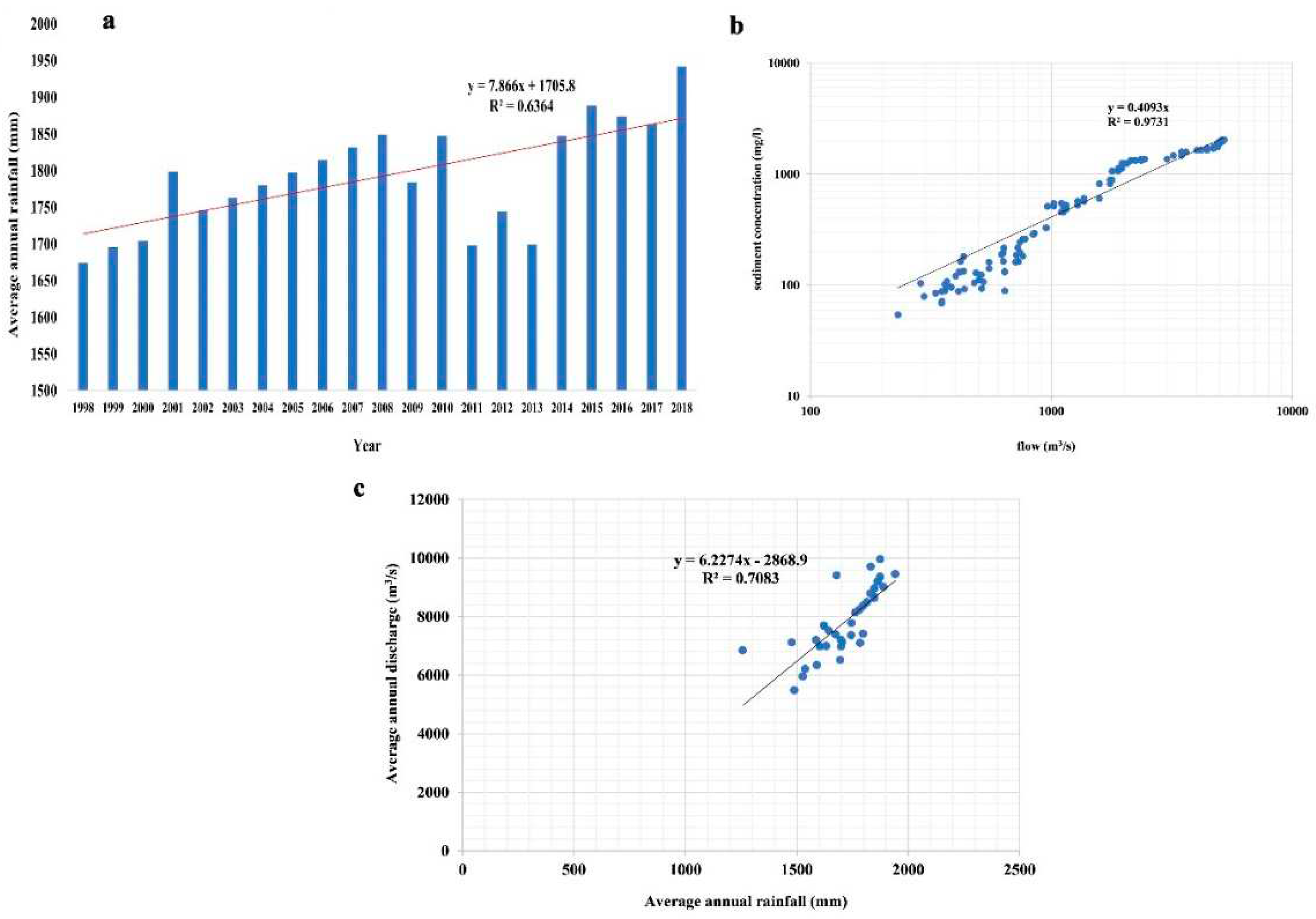
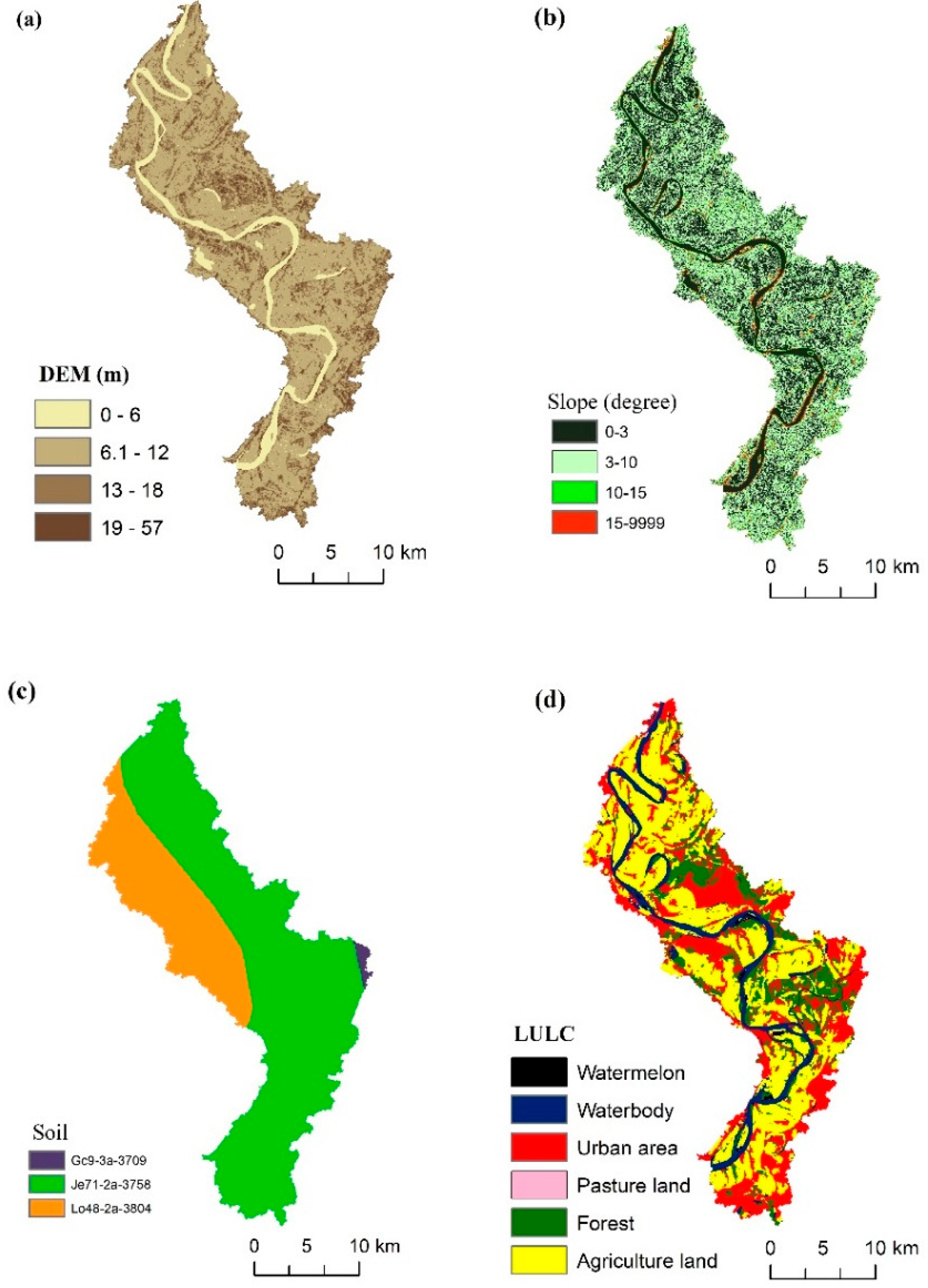
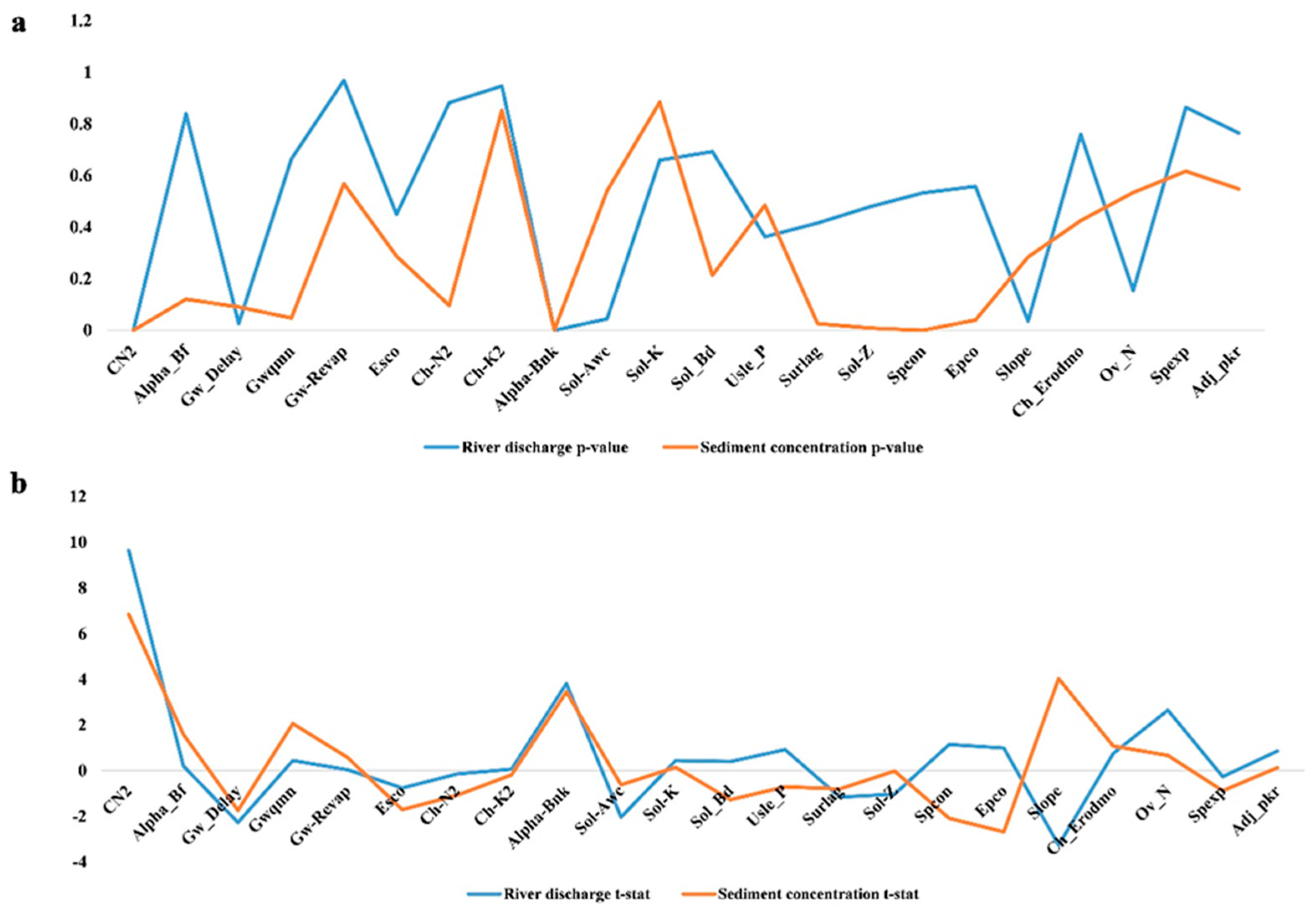
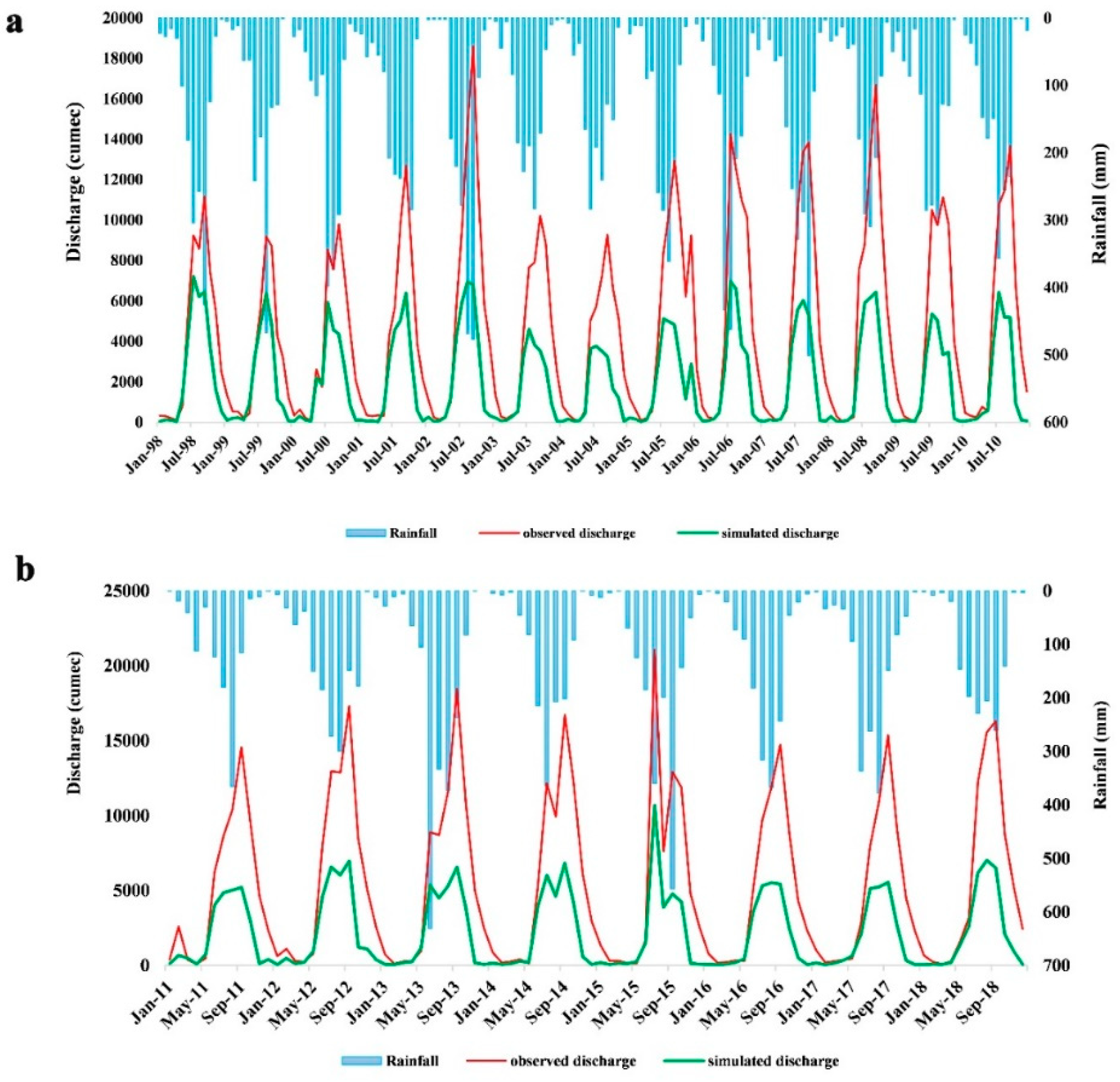
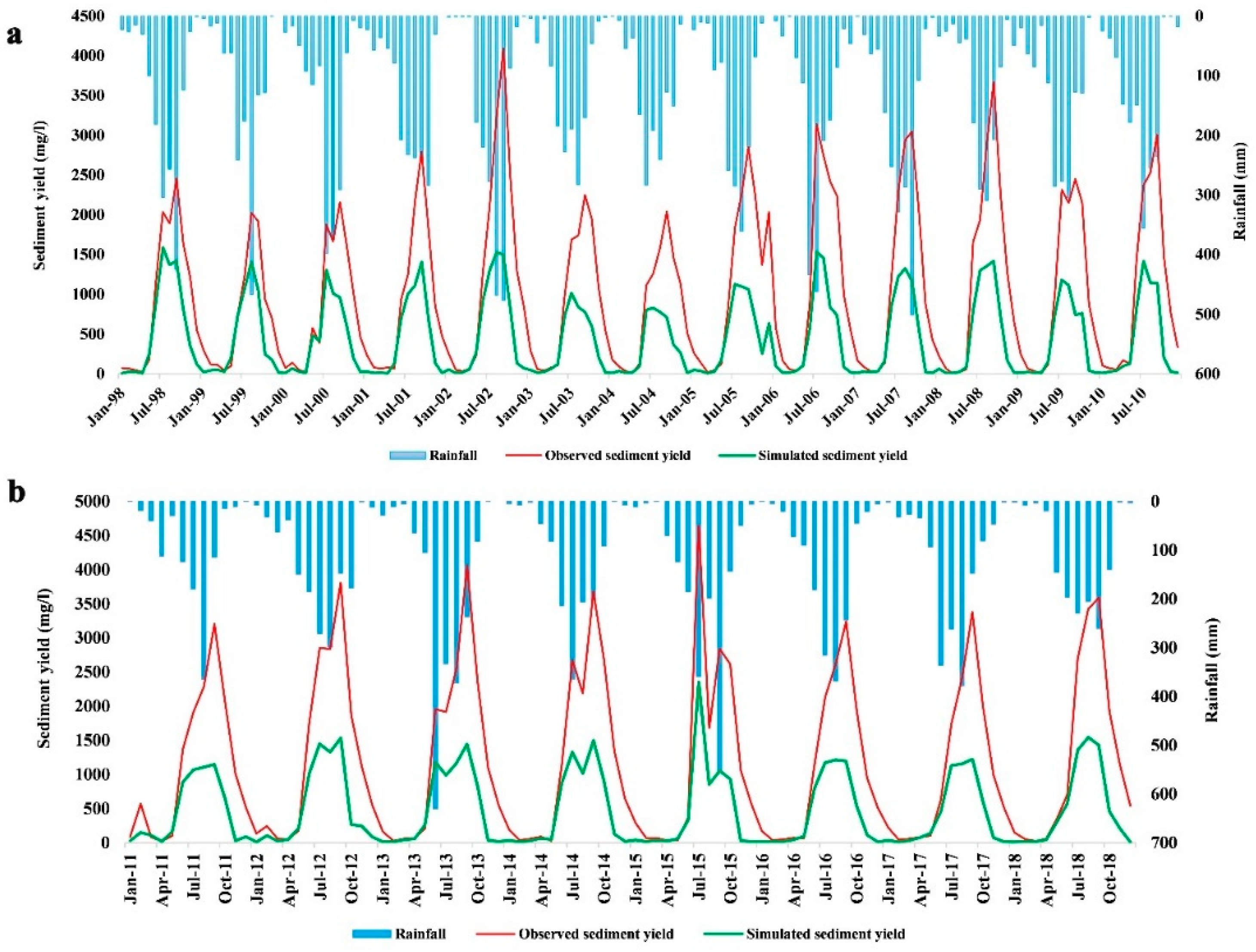
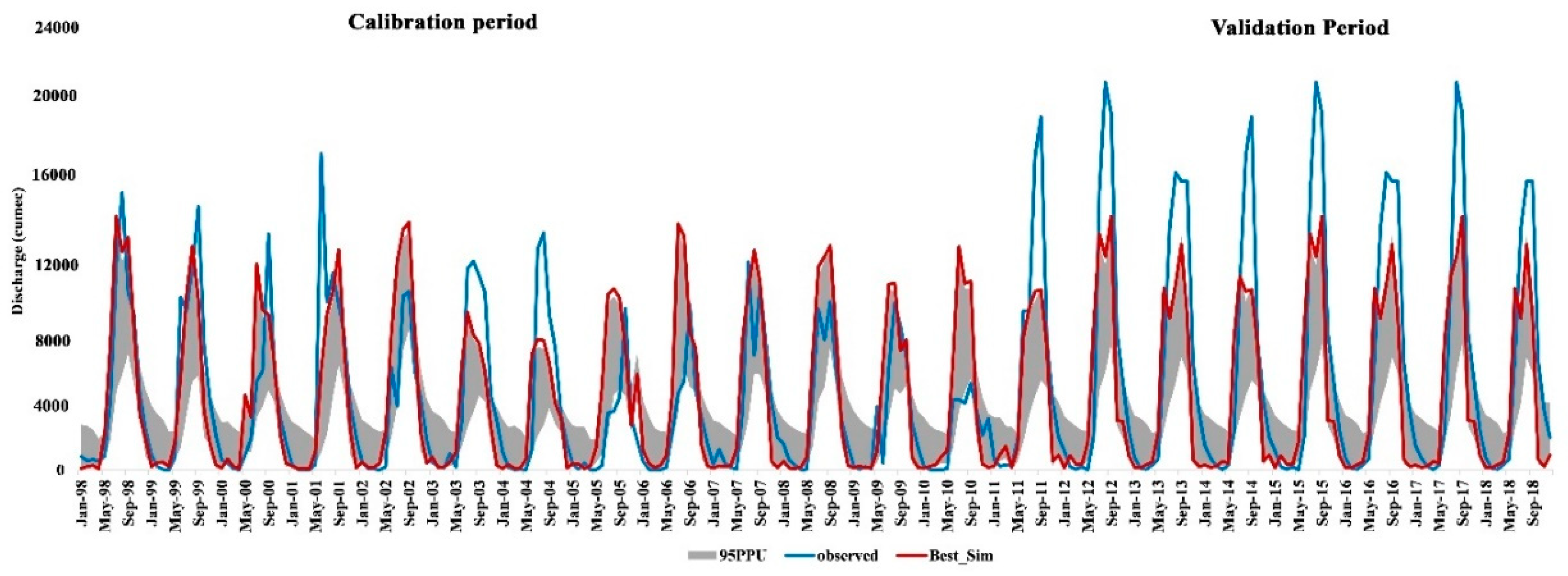

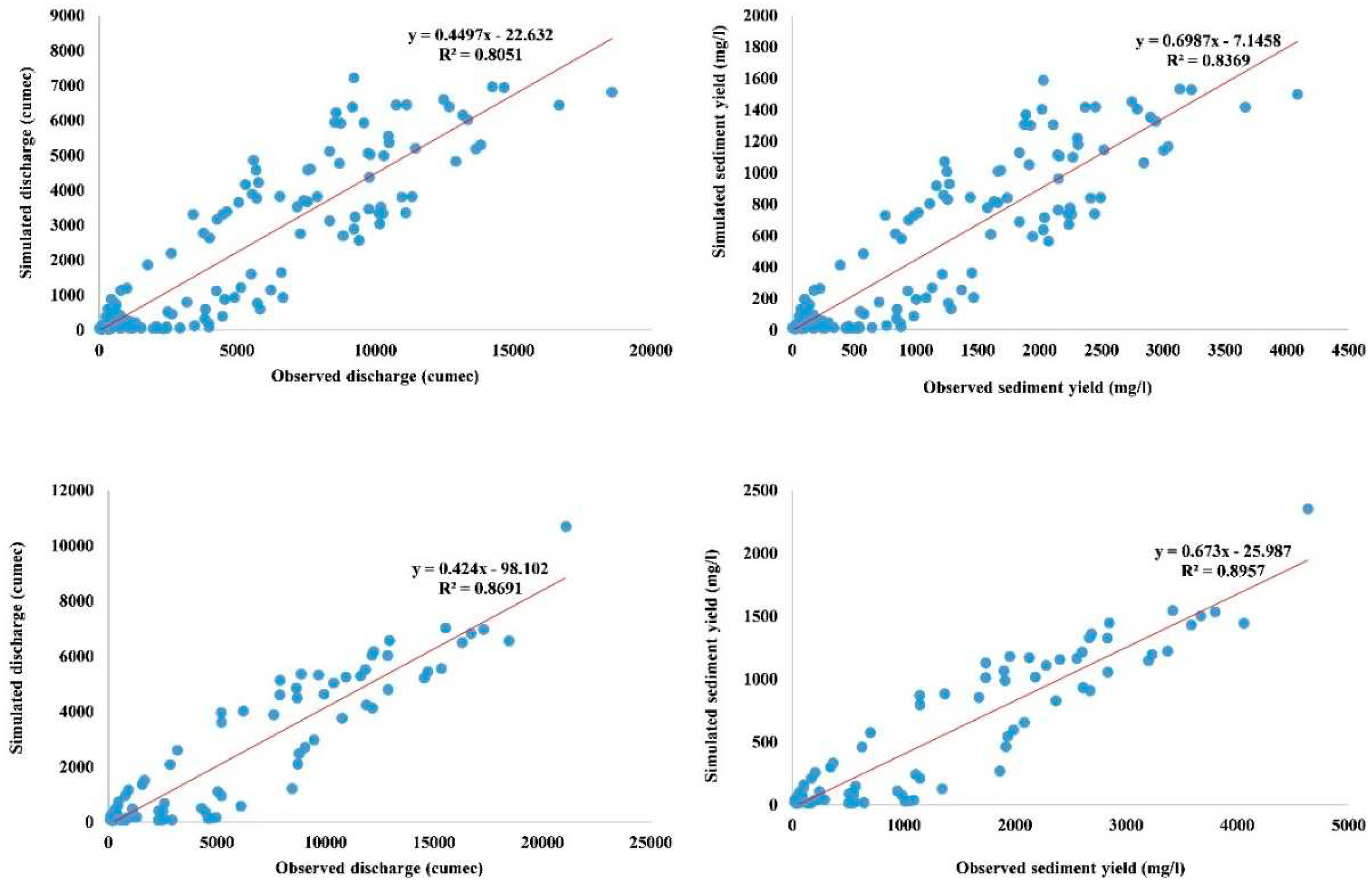
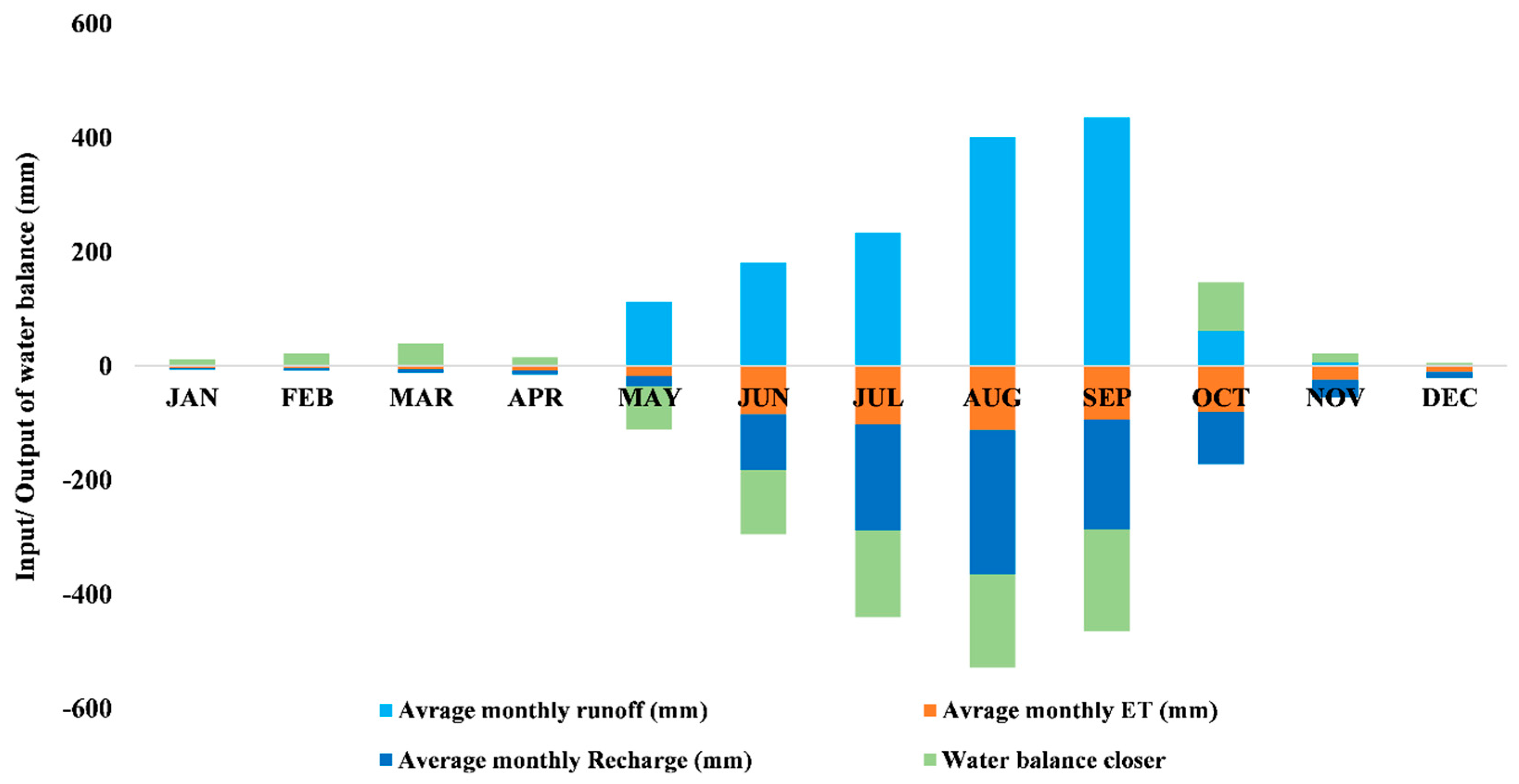
| Parameter with acronym | Parameter Name | Min value | Max value | Fitted value | Discharge sensitivity rank | Sediment concentration sensitivity rank |
|---|---|---|---|---|---|---|
| CN2 | Curve number | -0.2 | 0.2 | 0.186 | 5 | 5 |
| Alpha_Bf | Base flow alpha factor | 0 | 1 | 0.145 | 2 | 18 |
| Gw_Delay | Delay time of groundwater supply flow | 30 | 450 | 57.29 | 8 | 20 |
| Gwqmn | Shallow aquifer’s threshold water depth to return flow to occur | 0 | 2 | 0.19 | 11 | 12 |
| Gw¬¬_Revap | Groundwater revap coefficient | 0 | 0.2 | 0.129 | 1 | 22 |
| Esco | Compensation factor for evaporation from soil | 0.8 | 1 | 0.81 | 13 | 15 |
| Ch_N2 | Manning coefficient in the main channel | 0 | 0.3 | 0.211 | 9 | 3 |
| Ch_K2 | Hydraulic conductivity in the main channel | 5 | 130 | 78.13 | 6 | 2 |
| Alpha_Bnk | Baseflow alpha factor for bank storage | 0 | 1 | 0.625 | 16 | 15 |
| Sol_Awc | Available water capacity of soil layer | -0.2 | 0.4 | 0.085 | 3 | 22 |
| Sol_K | Saturated hydraulic conductivity | -0.8 | 0.8 | -0.456 | 12 | 16 |
| Sol_Bd | Density of soil mass | -0.5 | 0.6 | 0.518 | 10 | 11 |
| Usle_P | Factor related to soil conservation operations in the USLE equation | 0 | 1 | 0.45 | 14 | 14 |
| Surlag | Surface runoff lag coefficient | 0 | 10 | 7.51 | 7 | 6 |
| Sol_Z | Depth from soil surface to bottom layer | -25 | 25 | 4.23 | 4 | 13 |
| Spcon | Linear parameter for calculating sediment re-entrained in channel sediment routing | 0.0001 | 0.01 | 0.0067 | 15 | 1 |
| Epco | Plant uptake compensation factor | 0 | 1 | 0.58 | 19 | 17 |
| Slope | Tributary channel’s average slope | 0 | 5 | 2.14 | 17 | 4 |
| Ch_Erodmo | Channel erodibility coefficient | 0 | 1 | 0.61 | 18 | 7 |
| Ov_N | Coefcient of roughness of range | -0.5 | 0.5 | 0.29 | 21 | 8 |
| Spexp | Exponential re-entrainment coefficient for channel sediment routing | 1 | 1.5 | 1.34 | 22 | 9 |
| Adj_pkr | Peak rate adjustment factor for sediment routing in sub-basin | 0.5 | 2 | 1.87 | 20 | 10 |
| Sub-basin | Area (km2) | Rain (mm) | Surface runoff (mm) | Ground water movement (mm) | Total water yield (mm) | ET (mm) | Sediment (t/ha) |
|---|---|---|---|---|---|---|---|
| 1 | 369.5 | 1224 | 1025 | 53.25 | 363.57 | 336.47 | 33.54 |
| 2 | 401.3 | 1362 | 1147 | 47.24 | 457.81 | 408.53 | 39.14 |
| 3 | 321.4 | 1174 | 968 | 63.44 | 364.22 | 367.41 | 29.47 |
| 4 | 85.7 | 1284 | 1074 | 84.75 | 485.12 | 412.47 | 32.64 |
| Month | Rainfall (mm) | Surface runoff (mm) | Ground water movement (mm) | Total water yield (mm) | ET (mm) | Sediment (t/ha) |
|---|---|---|---|---|---|---|
| January | 1.94 | 0.23 | 0.07 | 0.35 | 3.25 | 0.01 |
| February | 1.45 | 0.35 | 0.08 | 0.47 | 4.15 | 0.01 |
| March | 1.46 | 0.48 | 0.14 | 0.81 | 5.96 | 0 |
| April | 1.68 | 0.96 | 0.21 | 0.91 | 7.41 | 0 |
| May | 178.48 | 112.36 | 2.54 | 32.41 | 17.42 | 0 |
| June | 219.78 | 180.95 | 3.24 | 88.74 | 31.24 | 14.2 |
| July | 277.78 | 234.15 | 5.74 | 101.36 | 42.85 | 22.4 |
| August | 467.91 | 401.36 | 6.39 | 157.41 | 51.42 | 27.8 |
| September | 476.79 | 435.21 | 5.41 | 74.81 | 31.74 | 34.2 |
| October | 87.84 | 61.47 | 3.24 | 12.36 | 15.24 | 21.4 |
| November | 17.86 | 5.84 | 0.04 | 3.24 | 2.54 | 0 |
| December | 0.11 | 0.09 | 0.005 | 0.006 | 1.14 | 0 |
Disclaimer/Publisher’s Note: The statements, opinions and data contained in all publications are solely those of the individual author(s) and contributor(s) and not of MDPI and/or the editor(s). MDPI and/or the editor(s) disclaim responsibility for any injury to people or property resulting from any ideas, methods, instructions or products referred to in the content. |
© 2024 by the authors. Licensee MDPI, Basel, Switzerland. This article is an open access article distributed under the terms and conditions of the Creative Commons Attribution (CC BY) license (http://creativecommons.org/licenses/by/4.0/).





